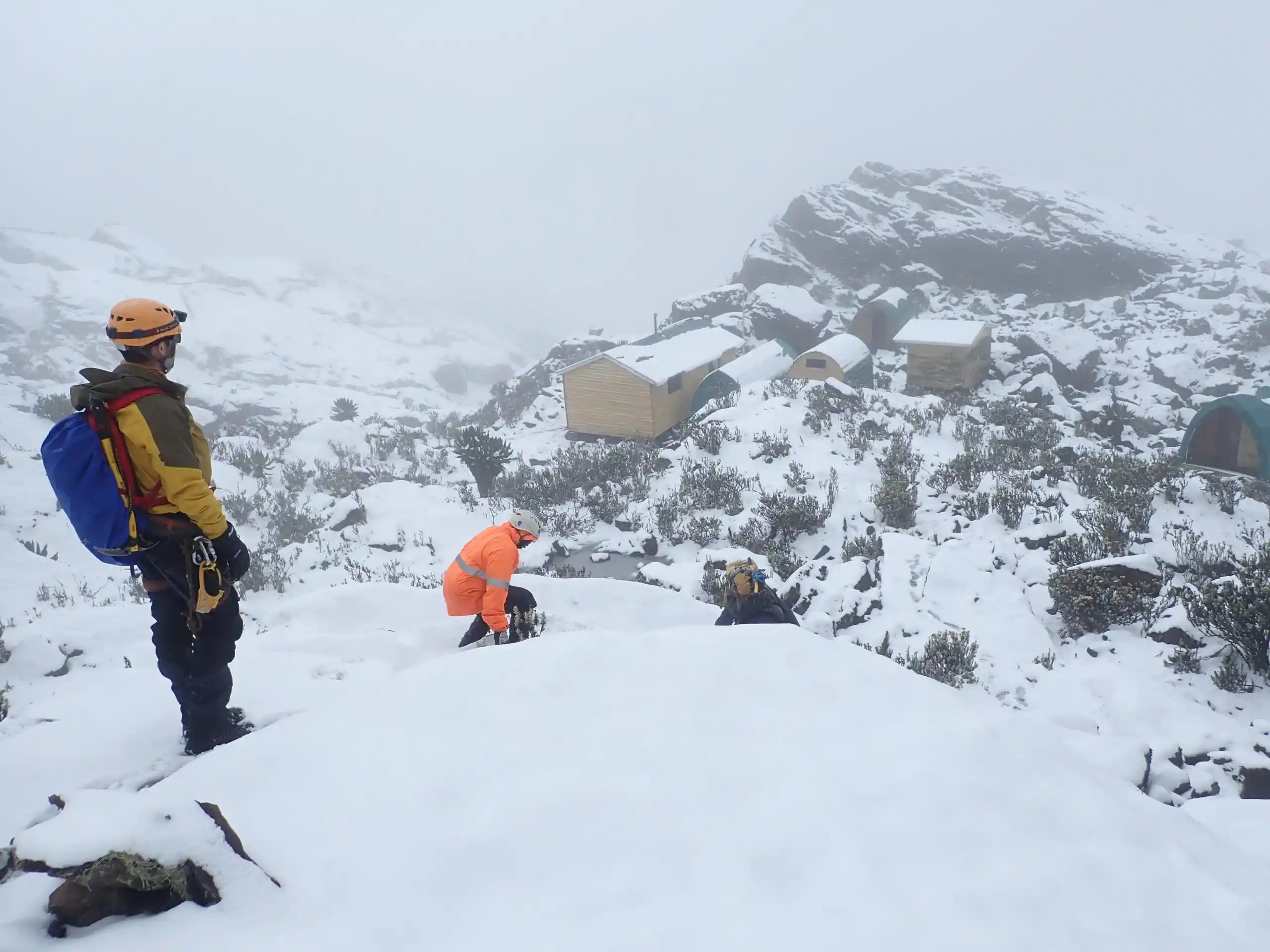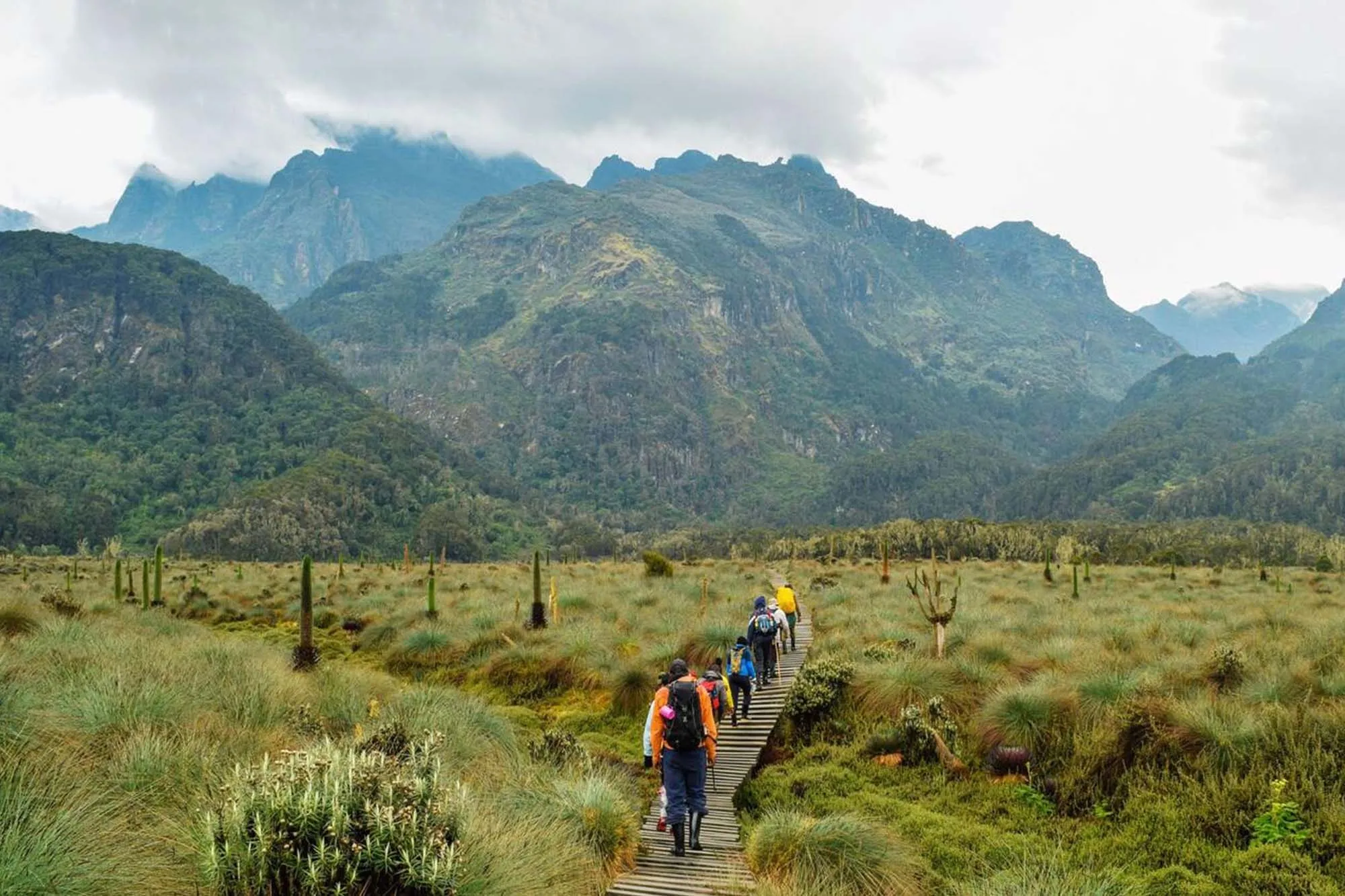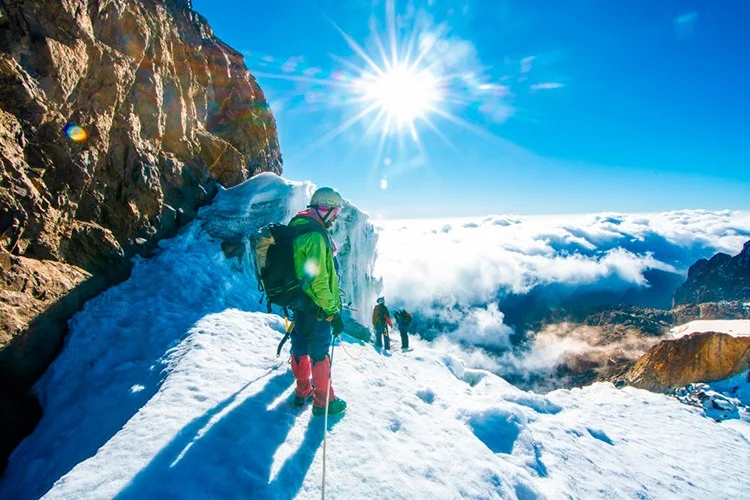Rwenzori Mountains
Rwenzori Mountains
The Rwenzori Mountains in Uganda are one of Africa’s most amazing natural wonders, even though they are not as famous as Mount Kilimanjaro. What makes them so special is their location—they sit right near the equator, where it’s usually hot and humid, but their peaks are so high that they’re covered in snow and ice all year round.
This strange mix of tropical jungle below and icy mountaintops above is what made the ancient Greek geographer Ptolemy call them the “Mountains of the Moon.” He even believed they were the source of the Nile River. For hundreds of years, these misty, snow-capped peaks have sparked stories and attracted brave explorers. Stretching over 120 kilometers along the border between Uganda and the Democratic Republic of Congo, the Rwenzori Mountains are the biggest mountain range in Africa and a proud UNESCO World Heritage Site. With glaciers, alpine meadows, and rare plants found nowhere else in the world, the Rwenzoris are a place of stunning contrasts and unforgettable beauty.
Location and Significance
The Rwenzori Mountains rise dramatically along the western border of Uganda, where they form a natural divide with the Democratic Republic of Congo. The range sits in the heart of the Albertine Rift Valley, a region known for its rich biodiversity and striking landscapes.
What makes the Rwenzoris even more appealing is their proximity to other incredible national parks. Just nearby is Queen Elizabeth National Park, famous for its tree-climbing lions, scenic boat cruises on the Kazinga Channel, and diverse wildlife. To the north, you’ll find Kibale Forest National Park, known as the primate capital of the world and one of the best places to track wild chimpanzees. A bit farther away—but well worth the journey—is Bwindi Impenetrable Forest, home to the largest population of mountain gorillas on Earth. These three parks form a perfect circuit for combining mountain trekking, wildlife safaris, and unforgettable primate encounters.
The name “Rwenzori” (sometimes spelled “Ruwenzori”) was given by Sir Henry Morton Stanley in 1888. It comes from the local Bakonzo language and translates to “cloud king” or “rain-maker,” a fitting name for a place known for its thick mists, frequent rainfall, and lush vegetation.


Trekking Rwenzori Mountains
Trekking in the Rwenzori Mountains is like walking through a world of changing landscapes. These mountains have six snowy peaks that rise above 5,000 meters. The highest of them is Mount Stanley, which reaches 5,109 meters at Margherita Peak—the third-highest mountain in Africa.
Unlike Mount Kilimanjaro, which has a more direct route to the top, the Rwenzori trails are wild and challenging. You’ll hike through muddy valleys, steep rocky ridges, and thick forests. It’s a real adventure that rewards those with endurance and determination.
If you are an experienced climber, summiting Margherita Peak is an unforgettable challenge. It requires technical gear like crampons, ropes, and ice axes. But if you’re in good shape and want something less technical, you can climb Weismann Peak. This trek doesn’t require climbing gear, but it’s still a tough and exciting hike.
Short on time? Day hikes are a great way to get a taste of the Rwenzoris. You can explore magical rainforests, spot waterfalls, and catch stunning views of the snow-covered peaks—all in a single day. One of the most amazing things about trekking here is how much the scenery changes. You start in a green, tropical forest full of life, then move into cool bamboo groves, open alpine meadows, and finally reach the icy, dramatic peaks. Each part of the journey feels like a new world, full of surprises and breathtaking views.
How Difficult Is Trekking in the Rwenzori Mountains?
Trekking in the Rwenzori Mountains is tough—it’s steep, muddy, and physically demanding. But if you are determined and have the right support, even the hardest trails can be conquered.
You won’t be alone. Every trek includes certified English-speaking guides, friendly porters, and skilled cooks who take care of your safety, carry your gear, and prepare hot, hearty meals. You’ll sleep in basic but cozy mountain huts, many with amazing views.
Because the mountains are so high, altitude sickness can be a real issue—especially if you’re climbing Margherita Peak. That’s why all trekking plans include rest days to help your body adjust to the altitude. Whether you’re an experienced climber or a strong hiker, having expert local guides makes your trek safer and more enjoyable.
To get the most out of your adventure, it’s important to prepare your body. Practice hikes, cardio workouts, and getting used to walking with a backpack will make a big difference. Also, be ready for wet, cold weather and sudden changes in temperature as you climb higher.
Signature Rwenzori Experiences
1. Weismann Peak Climb (4,620 meters)
Ideal for trekkers without technical climbing experience, the Weismann Peak climb is the most popular option for exploring the Rwenzori Mountains.
This 5-day trek includes four overnights in simple but scenic mountain camps, full porter and guide support, and nourishing meals along the route. An acclimatization day is built in, improving the likelihood of a successful summit. The trek’s diverse landscapes—from rainforest to moorland—offer an immersive mountain experience far from the tourist crowds.
Weismann Peak also provides photographers and nature lovers with unparalleled vistas. The sweeping views of the surrounding valleys, mist-covered forests, and neighboring peaks make each day on the trail feel like a journey through a hidden world.
2. Margherita Peak Climb (5,109 meters)
The ultimate Rwenzori adventure, the Margherita Peak climb is a serious expedition for experienced mountaineers. Over the course of 8 days and 7 nights, climbers face technical challenges that require full climbing gear and proficiency in glacier travel. Certified mountain guides ensure safety every step of the way.
One of the most recommended acclimatization hikes is to the Mutinda Lookout, which offers panoramic views and improves physical preparedness. Reaching Uganda’s highest point and the third-tallest peak in Africa is an achievement few can claim.
Expect to navigate icy terrain, steep inclines, and exposed ridgelines. This is a journey that will test your stamina, skill, and mental toughness—but the reward is an unmatched sense of accomplishment and awe-inspiring scenery.
3. Day Hikes and Nature Walks
Not every visitor has a week to spare or the desire to summit a peak.
Day trips through the lower elevations of the Rwenzori Mountains are equally rewarding. Trails follow the Muyambuli River through dense rainforest, where birdwatchers can spot endemic species like the Rwenzori Turaco. These six-hour excursions include a delicious packed lunch and expert-guided interpretation of the flora and fauna.
Nature walks can also include visits to waterfalls and natural hot springs, providing a relaxing break from more strenuous activities. These excursions are ideal for families, casual hikers, or anyone looking to experience the essence of the Rwenzori Mountains without the commitment of a multi-day trek.
Signature Rwenzori Experiences
The Rwenzori Mountains are home to the Bakonzo people, who have lived alongside these mountains for generations. They believe the mountains are sacred and full of spirits, and their culture is closely tied to the land. Meeting the Bakonzo offers a deeper understanding of life in this beautiful but remote area.
Visitors can take part in community tourism activities that support local families. You can stay in a village homestay, learn traditional dances, and take part in craft-making or cooking classes. For example, the Ruboni Community Camp near the park lets guests enjoy guided walks, storytelling, and even coffee tours—all run by locals.
These cultural experiences make your trek even more special. You don’t just see the mountains—you connect with the people who call them home. At the same time, your visit helps preserve their traditions and supports their livelihoods in a sustainable way.
Rwenzori Marathon
One of the most exciting events in the Rwenzori region is the annual Rwenzori Marathon, held in Kasese. This high-altitude race attracts runners from around the world and is officially recognized by World Athletics. It even serves as a qualifier for major international marathons. The route takes runners through scenic trails, rural villages, and lush forest paths—all set against the stunning backdrop of the Rwenzori Mountains.
But the marathon is more than just a race. It brings the community together, boosts local tourism, and supports the economy by creating jobs and attracting visitors. Shops, hotels, and small businesses all benefit during marathon season, turning the event into a festival of energy and excitement. Whether you’re a serious runner or a curious traveler, the Rwenzori Marathon offers something unique: a chance to challenge yourself in one of Africa’s most beautiful landscapes while celebrating resilience, culture, and nature all in one unforgettable event.
Best Time to Hike Rwenzori Mountains
You can hike the Rwenzori Mountains at any time of the year, but the best months are during the dry seasons: from December to February and July to August. During these times, the weather is more stable, and the trails are less muddy, making the trek safer and more enjoyable. In the rainy seasons, the paths can become very slippery and difficult, which makes hiking much harder.
Even though the Rwenzoris are breathtaking, they are still one of Africa’s less-visited mountain ranges. This means that even in the best hiking months, the trails are quiet and uncrowded. You’ll rarely meet many other hikers, giving you the chance to truly connect with nature. If you’re looking for a peaceful and wild adventure, far from busy tourist spots, the Rwenzori Mountains offer an unspoiled and unforgettable experience—especially when visited at the right time of year.
Getting There and What to Expect
Most travelers arrive in Uganda through Entebbe International Airport or the capital city, Kampala. From there, it’s a scenic drive of about 5 hours west to the foothills of the Rwenzori Mountains. The area is also close to some of Uganda’s top wildlife spots, like Bwindi Impenetrable Forest for gorilla trekking and Kibale Forest for chimpanzee tracking—making it easy to combine mountain hiking with other adventures.
When you visit the Rwenzoris, expect the unexpected: quick weather changes, misty forests, and dramatic mountain views. Whether you’re up for a tough summit climb or a relaxed nature walk, the experience is always rewarding. Every trail reveals new landscapes—from waterfalls to snow-capped peaks.
If you’re staying longer, the nearby town of Kasese has friendly lodges, local markets, and access to more attractions like crater lakes and cultural villages. Many travelers choose to include a Rwenzori trek as part of a larger Uganda safari, turning one trip into a full journey of nature, wildlife, and culture.
More Destinations

Guided by a genuine passion to share Uganda's Wonders with you.
About Us
Our warmth and extensive safari knowledge allow us to offer authentic, immersive, and remarkable experiences that leave a positive impact on Africa’s crucial wilderness areas.




